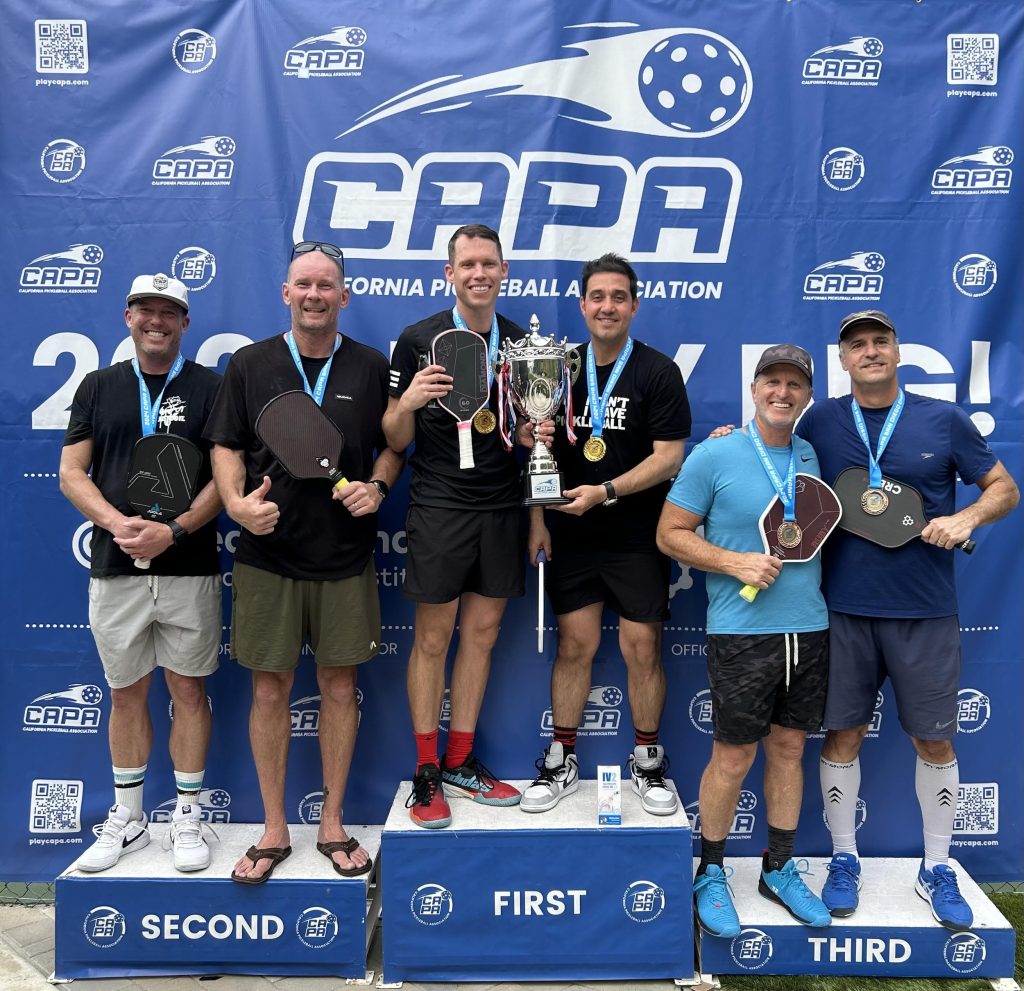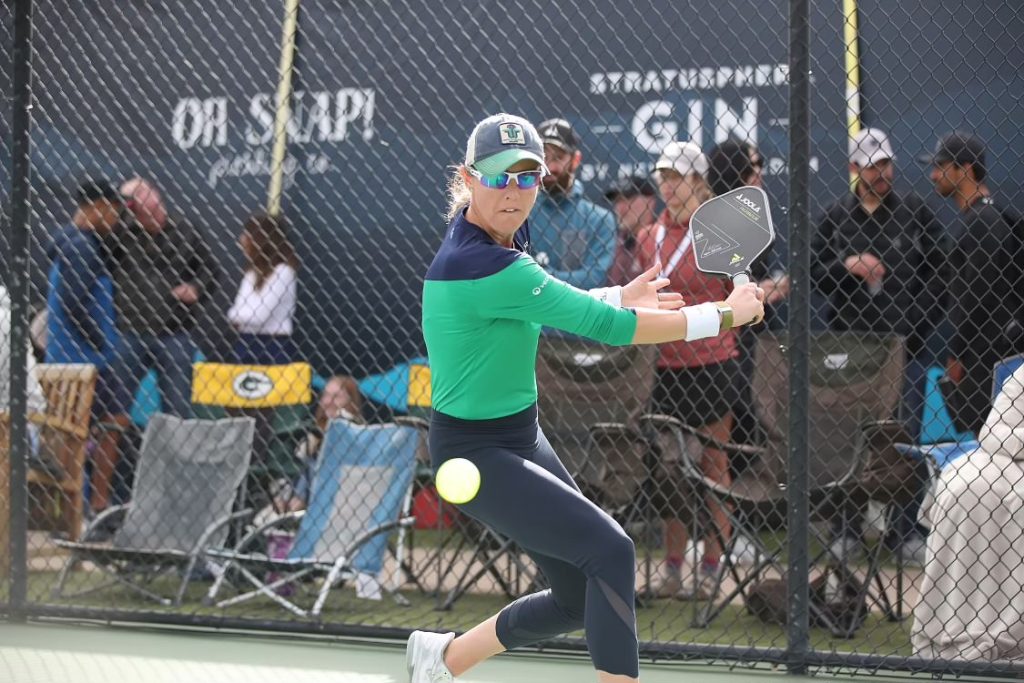From the backyard to the big leagues: pickleball’s expanding professional world
By: Jenny Brown

“I’ve always been somebody who’s done hobbies. I did triathlons for years, I was involved in salsa dancing…tango.”
At first, pickleball was just another one of Jessica Improta’s hobbies. In 2021, she was one of five million Americans who picked up a paddle that summer while on a trip to Texas. With a new sport to obsess over, Improta began rallying with two 75-year-old players at her local park in Santa Monica. The sport gave her the community she was missing. After playing in smaller tournaments across Southern California, Improta secured gold at the Newport Beach Takeya Showcase, a Professional Pickleball Association (PPA) tournament, where she had her first taste of the sport’s emerging professional world.
“I remember walking in and it was packed and buzzing. There were sponsors,” says Improta. “It was really wild to see that there was this level of participation.”
Founded in 2018, the PPA is one of the leading organizations for professional pickleball in the United States. With an emphasis on organizing high-caliber tournaments and growing the sport, the PPA has elevated pickleball’s popularity and financial status, awarding pro players over $5.5 million in annual prize money in 2023. The explosion of the sport is inspiring athletes from tennis, badminton, volleyball and beyond to try their shot at professional success.
Amateur pickleball player Angus Lee was lucky to secure one of the remaining spots in the PPA Main draw last January. Lee recalls the intensity of playing against high level pro players.
“You can see the shots they made, it’s just more confident and aggressive,” says Lee. “It’s very fun to get a game against one of the top pros, and then see how far the sport can bring you.”
Lee, who is originally from Hong Kong, was introduced to the sport eight years ago while attending college in Tennessee. He moved to Los Angeles and began coaching pickleball in 2021. While working his way into the professional division, Lee started the California Pickleball Association (CAPA) in the hopes of expanding the tournament industry.

In June of 2022, Lee and his co-founder Derek organized three tournaments in the Southern California region. CAPA adopts the round robin tournament style, allowing players to compete against all other players in their bracket. While this format is not only attractive to amateur players looking for extra court time, Lee believes that CAPA is also an influential space for upcoming pros, with lower entry fees and the freedom to try out partnerships before the pro level.
“I think this is a good way to let the upcoming pros experience playing against higher level players without worrying about losing two matches, getting out of the tournament or lowering their rating,” Lee said.
Screenwriter and aspiring pickleball pro Josh Maya is thankful for local tournament organizers like Lee for providing these playing opportunities in Southern California. Between writing and coaching at USC and the Valley Hunt Club in Pasadena, Maya tries to participate in a tournament every month. However, events have been quickly filling up, particularly at the amateur level. To keep up his competitive edge with this growing number of players, Maya is now carving out at least a couple of drills sessions or high level playing sessions per week.

“And it’s tough, it’s a sacrifice that you have to make. I’d love to come home after coaching and watch a show or go out and go to a restaurant, but for me, the sacrifice is worth it,” says Maya. “I’m choosing with that time to go drill and go play some focused, intentional, high level pickleball.”
2023 was the first year CAPA organized a full year of tournaments. With tournament playership increasing from an average of 500 to 700 players, Lee is busy securing venues at least a half a year in advance to hold the growing number of participants.
Amateur tournaments are not the only thing in high demand for the aspiring pro community – court space is necessary for all pickleball players to excel in the game. According to the court locator site “Pickleheads”, there are 79 centers to play at in Los Angeles County. Some courts share with tennis players, others are established, and all of them are being fought over by members of the pickleball community.
“The interest and the willingness to pay is off the charts,” says Jessica Improta.
Improta found her home at the Santa Monica Pickleball Center, where she coaches and drills for tournaments. Between maintaining her therapy practice and coaching 10 hours a week at the center, her free time is spent thinking about pickleball.
“If I’m not doing therapy, I’m playing pickleball, I’m coaching pickleball and thinking about pickleball. It’s a real problem. I mean, it’s a good problem.”
Jessica Improta, pickleball player

Whether you’re at the amateur or pro level, tournaments are expensive. With equipment costs and amateur fees ranging from $80-130 per event, Improta’s devotion to the game has impacted both her occupational and financial decisions.
“Last year, my lease was up on my car and I decided to not lease anymore. I wanted to be able to put miles on the car because I knew I would be driving for pickleball.”
For non-contracted players like Jessica, making it to the professional draw isn’t a guarantee. For all three professional brackets, PPA progressive tournaments require players to block out up to four days of playing. This format makes it difficult for non-salaried players to balance the touring pro life with other commitments. Just a few years ago many high level pros still held full or part-time jobs.
“It’s very difficult for people now to balance the fact they have other lives. You can’t support yourself as a pro the same way that you can in tennis.”
Ranked 38th in women’s doubles tennis in 2019, Kaitlyn Christian has had her fair share of jobs in the racquet sports world, whether it’s participating in ITF and WTA matches or as an on-screen body double for Emma Stone in Battle of the Sexes. It was during her off-seasons where she and her father would “dink” around at their home pickleball court in Rancho Cucamonga.

While she had played a number of pickleball tournaments since 2018, Kaitlyn Christian said it was “sheer luck” that she was drafted by the PPA, which began signing players last August.
For those drafted into the PPA, pickleball can be a full time job, allowing players to no longer rely solely on sponsorships and results for financial support. With at least 24 PPA events scheduled for this year, Christian is keeping busy. But she’s also experiencing a more flexible lifestyle than her years in tennis while on PPA’s domestic tour.
“I have routines at home, I get to see my dogs, I get to hang out with my parents, it’s just a lot of fun. But, in tennis, you get to travel to amazing places, meet new people and learn a lot about different cultures. So there’s definitely a give and take.”
Kaitlyn Christian, professional pickleball player
With a lack of traveling coaches and growing number of salaried players, pickleball still has a way to go in terms of professional development, lacking the money and resources of its older sister tennis.
“In tennis you’ve got a player lounge and security guards escorting you from court to court,” says Christian. “In pickleball, it’s kind of a free for all. There’s not a lot of space that you can just go to, to get away and be by yourself.”
While the two sports are in different financial states, both require similar amounts of recovery and training. Trainers, masseuses and ice baths can be helpful when playing at an elite level. But without the financial support, these resources aren’t available to most lower level pro players.
“Physical therapy, mental coaches. Many of the pros now are working with sports psychologists. They’re all treating it like tennis, but it doesn’t have tennis money,” says Improta.
But the money is starting to come in. This February, the PPA merged with the team-based Major League Pickleball (MLP). PPA contracted players are now free to join one of the 24 co-ed MLP teams that now operate together under a single holding company. According to PPA tournament founder Connor Pardoe, this unification is projected to increase annual payouts by 250% compared to 2023.
Christine Maddox, who played against Christian at the PPA Arizona Cup, was drafted into the MLP SoCal Hard Eights team at the start of April. As her pro career in the MLP and PPA begins to take off, Maddox feels support from the pickleball community. The feeling is unmatched compared to her years playing tennis.

“There is still competition. Don’t get me wrong,” says Maddox. “But there’s just this lightness to it that wasn’t there for tennis…It’s a fun time.”
And Maddox isn’t alone in her love for the pickleball community. It seems this obsession for the game, what some call the “pickleball bug”, has created a group of consistent players coming back to the court each week to play, socialize and dream of becoming pro. And for this newer, younger batch of players, a more fast and aggressive gameplay is evolving.
As the director of the Santa Monica Pickleball Center and an MLP Coach, senior pro Julio Rivera is continuing to have a thriving professional career. As he prepares for the US Open of Pickleball, one of the first and most prestigious tournaments for the sport, Rivera recognizes that his career goals differ from younger pros like Christian and Maddox, with physical longevity at the forefront of his mind.
“The question is how, how healthy am I going to stay?” Rivera said. “I’ll focus on my health, my nutrition, my flexibility. Those are the things that will tell me how long I’ll be able to keep playing.”
With her senior pro career only five years away, Jessica recognizes that her trajectory will differ from the emerging pros.
“I have to really juggle, do I have time to play qualifying? Do I have a good enough partner? I think at my age, the returns are less and less. I’m not going to be a touring pro the same way that a 25 year old might have a chance of getting a turn. I might win a match here and there, but my body doesn’t recover the way that I used to. But, you know, I mean, it’s still inside. I want to be the best 45-year-old player out there.”
As a sport that’s been marketed as low impact and most likely dominated your local senior center, some may be surprised by how the sport’s professional scene is getting younger and younger. With 17-year-old Anna Leigh Waters ranked No. 1 in the world for the sport, she and other younger pros are entering the scene with great success. Improta sees this younger generation as the ones who will shape the future of pickleball into a fully established professional sport.
“In the next few years, you’re really going to see these very explosive, talented players coming up through the ranks, still financially supported and able to dedicate themselves to the sport,” says Improta.
Between the launch of Tennis Channel’s PickleballTv network and the Global Pickleball Federation, 2023 was a year of significant growth and development for the sport with national and international audiences. While pickleball is not at Olympic status quite yet, the new pros are ready to hit the ground running to make pickleball a game that’s as fast, exciting and infectious as their love for playing.
“It’s at such a young stage right now, where I think it’s a great time to get involved,” says Christian. “I’m here to embrace it and enjoy every moment of it.”